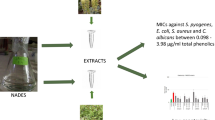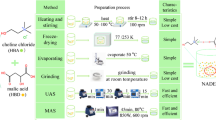Abstract
Natural deep eutectic solvents (NADES) are a new generation of green solvents. They are mixtures of two or three compounds such as choline chloride as a cationic salt and alcohols, acids, amides, amines or sugars as hydrogen-bond donors. Although the majority of NADES’ components are of natural origin and therefore NADES are often presumed to be non-toxic, the evaluation of their toxicity and biodegradability must accompany the research on their synthesis and application. Therefore, the aim of this work was to investigate the effect of ten synthesised NADES towards bacteria (i.e., Escherichia coli, Proteus mirabilis, Salmonella typhimurium, Pseudomonas aeruginosa, Staphylococcus aureus), yeast (i.e., Candida albicans) and human cell lines (i.e., HeLa, MCF-7 and HEK293T). In addition, oxygen radical absorbance capacity (ORAC) method was used to determine the antioxidative activity of the tested NADES. Differences in toxicity response between microorganisms and cell lines were observed, and only NADES that contained organic acid showed toxicity towards the test systems. Furthermore, the NADES containing compounds that possess antioxidative activity also showed antioxidative activity. However, research whose primary purpose is the synthesis and application of NADES must be followed by an evaluation of their biological properties (e.g., antimicrobial activity, toxicity towards animal cells and antioxidative or other biological activity) to find the solvent with the best profile for wider industrial applications.


Similar content being viewed by others
References
Abbott AP, Boothby D, Capper G, Davies DL, Rasheed RK (2004) Deep eutectic solvents formed between choline chloride and carboxylic acids: versatile alternatives to ionic liquids. J Am Chem Soc 126:9142–9147
Abbott AP, Cullis PM, Gibson MJ, Harris RC, Raven E (2007) Extraction of glycerol from biodiesel into a eutectic based ionic liquid. Green Chem 9:868–872
Alirezaei M, Khoshdel Z, Dezfoulian O, Rashidipour M, Taghadosi V (2015) Beneficial antioxidant properties of betaine against oxidative stress mediated by levodopa/benserazide in the brain of rats. J Physiol Sci 65:243–252
Butler M (2004) Animal cell culture and technology, 2nd edn. Garland Science/Bios Scientific Publishers, New York
Castilho LR, Moraes AM, Augusto EFP, Butler M (2008) Animal cell technology: from biopharmaceuticals to gene therapy. Taylor & Francis Group, New York
Chen H, Yao J, Wang F, Zhou Y, Chen K, Zhuang R, Choi MMF, Zaray G (2010) Toxicity of three phenolic compounds and their mixtures on the Gram-positive bacteria Bacillus subtilis in the aquatic environment. Sci Total Environ 408:1043–1049
Cvjetko Bubalo M, Mazur M, Radošević K, Radojčić Redovniković I (2015) Baker’s yeast-mediated asymmetric reduction of ethyl 3-oxobutanoate in deep eutectic solvents. Process Biochem 50:1788–1792
Cvjetko Bubalo M, Ćurko N, Tomašević M, Kovačević Ganić K, Radojčić Redovniković I (2016) Green extraction of grape skin phenolics by using deep eutectic solvents. Food Chem 200:159–166
Dai Y, van Spronsen J, Witkamp GJ, Verpoorte R, Choi YH (2013) Natural deep eutectic solvents as new potential media for green technology. Anal Chim Acta 766:61–68.
Egorova KS, Ananikov VP (2014) Toxicity of ionic liquids: eco(cyto) activity as complicated, but unavoidable parameter for task-specific optimization. Chem Sus Chem 7:336–360
Fadli M, Chevalier J, Saad A, Mezrioui NE, Hassani L, Pages JM (2011) Essential oils from Moroccan plants as potential chemosensitisers restoring antibiotic activity in resistant Gram-negative bacteria. Int J Antimicrob Agents 38:325–330
Florindo C, Oliveira FS, Rebelo LPN, Fernandes AM, Marrucho IM (2014) Insights into the synthesis and properties of deep eutectic solvents based on cholinium chloride and carboxylic acids. ACS Sustain Chem Eng 2:2416–2425
Fu M, Qin C, Li W, Yan Y, Zeng L, Yang X (2013) Effect of glucosamine and chitooligomer on the toxicity of arsenite against Escherichia coli. Carbohydr Polym 91:390–393
Gauniya A, Das S, Mallick S, Basu S (2010) Comparative bioavailability studies of citric acid and malonic acid based aspirin effervescent tablets. Int J Pharm Bio Sci 2:118–120
Gutierrez MC, Ferrer ML, Mateo CR, del Monte F (2009) Freeze-drying of aqueous solutions of deep eutectic solvents: a suitable approach to deep eutectic suspensions of self-assembled structure. Langmuir 25:5509–5515
Hakeem KR, Rehman RU, Tahir I (2014) Plant signaling: understanding the molecular crosstalk. Springer, India
Hayyan M, Hashim MA, Al-Saadi MA, Hayyan A, AlNashef IM, Mirghani ME (2013) Assessment of cytotoxicity and toxicity for phosphonium-based deep eutectic solvents. Chemosphere 93:455–459
Hayyan M, Looi CY, Hayyan A, Wong WF, Hashim MA (2015) In vitro and in vivo toxicity profiling of ammonium-based deep eutectic solvents. PLoS One 10:e0117934. https://doi.org/10.1371/journal.pone.0117934
Hayyan M, Mbous YP, Looi CY, Wong WF, Hayyan A, Salleh Z, Mohd-Ali O (2016) Natural deep eutectic solvents: cytotoxic profile. SpringerPlus 5:913–924
Jardim WF, Pasquini C, Guimarães JR, de Faria LC (1990) Short-term toxicity test using Escherichia coli: monitoring CO2 production by flow injection analysis. Water Res 24:351–354
Juneidi I, Hayyan M, Ali OM (2016) Toxicity profile of choline chloride-based deep eutectic solvents for fungi and Cyprinus carpio fish. Environ Sci Pollut Res 23:7648–7659
Karadag A, Ozcelik B, Saner S (2009) Review of methods to determine antioxidant capacities. Food Methods 2:41–66
Matzke M, Arning J, Johannes R, Jastorff B, Stolte S (2010) Design of inherently safer ionic liquids: toxicology and biodegradation. In: Wasserscheid P, Stark A (ed) Handbook of green chemistry, Volume 6: Ionic liquids. Wiley-VCH Verlag GmbH & Co., Weinheim, pp. 235–298
Mbous YP, Hayyan M, Wong WF, Looi CY, Hashim MA (2017) Unraveling the cytotoxicity and metabolic pathways of binary natural deep eutectic solvent systems. Sci Rep 7:41257
Nam MW, Zhao J, Lee MS, Jeong JH, Lee J (2015) Enhanced extraction of bioactive natural products using tailor-made deep eutectic solvents: Application to flavonoid extraction from Flos sophorae. Green Chem 17:1718–1727.
Ninfali P, Mea G, Giorgini S, Rocchi M, Bacchiocca M (2005) Antioxidant capacity of vegetables, spices and dressings relevant to nutrition. Methods Enzymol 93:257–266
Ozturk SS, Hu WS (2006) Cell culture technology for pharmaceutical and cell-based therapies. Taylor & Francis Group, New York
Paiva P, Craveiro R, Aroso I, Martins M, Reis RL, Duarte ARC (2014) Natural deep eutectic solvents—solvents for the 21st century. ACS Sustain Chem Eng 2:1063–1071
Radošević K, Cvjetko Bubalo M, Gaurina Srček V, Grgas D, Landeka Dragičević T, Radojčić Redovniković I (2015) Evaluation of toxicity and biodegradability of choline chloride based deep eutectic solvents. Ecotoxicol Environ Saf 112:46–53
Radošević K, Ćurko N, Gaurina Srček V, Cvjetko Bubalo M, Tomašević M, Kovačević Ganić K, Radojčić Redovniković I (2016) Natural deep eutectic solvents as beneficial extractants for enhancement of plant extracts bioactivity. LWT Food Sci Technol 73:45–51
Ratriyanto A, Mosenthin R, Bauer E, Eklund M (2009) Metabolic, osmoregulatory and nutritional functions of betaine in monogastric animals. Asian Aust J Anim Sci 22:1461–1476
Silva SNRL, Farias CBB, Rufino RD, Luna JM, Sarubbo LA (2010) Glycerol as substrate for the production of biosurfactant by Pseudomonas aeruginosa UCP0992. Colloids Surf B 79:174–183
Spaulding AR, Lin YC, Merriman JA, Brosnahan AJ, Peterson ML, Schlievert PM (2012) Immunity to Staphylococcus aureus secreted proteins protects rabbits from serious illnesses. Vaccine 30:5099–5109
Stratford M, Plumridge A, Nebe-von-Caron G, Archer DB (2009) Inhibition of spoilage mould conidia by acetic acid and sorbic acid involves different modes of action, requiring modification of the classical weak-acid theory. Int J Food Microbiol 136:37–43
Tang X, Liu J, Dong W, Li P, Li L, Lin C, Zheng Y, Hou J, Li D (2013) The cardioprotective effects of citric acid and L-malic acid on myocardial ischemia/reperfusion injury. Evid Based Complement Alternat Med 2013:1–11
Triantis T, Papadopoulos K, Dimotikali D, Nikokavouras J (2001) Evaluation of food antioxidant activity by photostorage chemiluminescence. Anal Chim Acta (2):263–268
Wang YM, van Eys J (1981) Nutritional significance of fructose and sugar alcohols. Annu Rev Nutr 1:437–475
Wen Q, Chen JX, Tang YL, Wang J, Yang Z (2015) Assessing the toxicity and biodegradability of deep eutectic solvents. Chemosphere 132:63–69
Wikene KO, Håkon VR, Ellen B, Hanne HT (2017) Investigation of the antimicrobial effect of natural deep eutectic solvents (NADES) as solvents in antimicrobial photodynamic therapy. J Photochem Photobiol B Biol 171:27–33
Young YF, Lee HJ, Shen YS, Tseng SH, Lee CY, Tai NH, Chang HY (2012) Toxicity mechanism of carbon nanotubes on Escherichia coli. Mater Chem Phys 134:279–286
Zhao BY, Xu P, Yang FX, Wu H, Zong MH, Lou WY (2015) Biocompatible deep eutectic solvents based on choline chloride: characterization and application to the extraction of rutin from Sophora japonica. ACS Sustain Chem Eng 3:2746–2755
Funding
The work was supported through the Croatian Science Foundation HRZZ (Grant No. 9550).
Author information
Authors and Affiliations
Corresponding author
Additional information
Responsible editor: Philippe Garrigues
Highlights
• Differences in natural deep eutectic solvents (NADES) toxicity responses between bacteria and cell lines were observed.
• NADES containing organic acid possess toxicity.
• BMaPro had a beneficial effect on the proliferation of all tested cell lines.
• NADES could possess antioxidative activity.
Rights and permissions
About this article
Cite this article
Radošević, K., Čanak, I., Panić, M. et al. Antimicrobial, cytotoxic and antioxidative evaluation of natural deep eutectic solvents. Environ Sci Pollut Res 25, 14188–14196 (2018). https://doi.org/10.1007/s11356-018-1669-z
Received:
Accepted:
Published:
Issue Date:
DOI: https://doi.org/10.1007/s11356-018-1669-z




